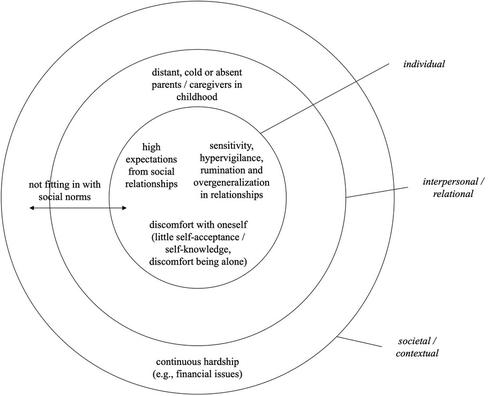片刻与一生:人们生活经历中的孤独模式和感知原因
IF 4.8
3区 综合性期刊
Q1 MULTIDISCIPLINARY SCIENCES
引用次数: 0
摘要
为了有效地干预孤独,我们需要更好地理解为什么有些孤独经历会持续(通常被称为慢性孤独),而大多数孤独经历只是短暂的。为进一步研究慢性孤独的原因,我们重新分析了来自印度、埃及、土耳其、以色列、保加利亚和奥地利的19-45岁成年人的访谈数据。由于对慢性孤独和短暂孤独的确切定义缺乏科学共识,因此首先在数据中区分了不同的孤独时间模式。出现了四种类型的孤独,而不是两种:短暂的孤独通常持续几个小时到两年;复发性孤独每隔几周或几个月复发一次;长期的孤独持续多年;慢性孤独通常始于童年或青春期,并持续了大多数人的一生。在这四种时间模式中比较了孤独感的感知原因,结果显示,短暂或长期的孤独感通常归因于具体的外部环境,但长期的孤独感更多地是由童年时期不满意的家庭关系、不适应社会规范的感觉或对关系的高期望来解释的。复发性和慢性孤独通常归因于敏感、反刍、关系中的过度概括或对自己的不适(例如,低自我接受度)。本文章由计算机程序翻译,如有差异,请以英文原文为准。

A Moment Versus a Lifetime: Patterns of Loneliness and Perceived Causes in People's Lived Experiences
For effective loneliness interventions, we need a better understanding of why some loneliness experiences persist (often labeled chronic loneliness), while most loneliness experiences remain transient. To provide starting points for future research on causes of chronic loneliness, interview data from adults ages 19–45 years from India, Egypt, Turkey, Israel, Bulgaria, and Austria were reanalyzed. Because of little scientific consensus on the exact definition of chronic versus transient loneliness, different temporal patterns of loneliness were first distinguished in the data. Instead of two, four types emerged: Transient loneliness typically lasted some hours to 2 years; recurrent loneliness recurred every couple of weeks or months; prolonged loneliness lasted for multiple years; and chronic loneliness usually had its onset in childhood or adolescence and persisted for most people's lives. Perceived causes for loneliness were compared across those four temporal patterns, with findings showing that transient or prolonged loneliness was typically attributed to concrete external situations, but chronic loneliness was explained more by unfulfilling family relationships in childhood, perceptions that one does not fit in with societal norms, or high relationship expectations. Both recurrent and chronic loneliness were often attributed to sensitivity, rumination, overgeneralizations in relationships, or discomfort with oneself (e.g., low self-acceptance).
求助全文
通过发布文献求助,成功后即可免费获取论文全文。
去求助
来源期刊

Annals of the New York Academy of Sciences
综合性期刊-综合性期刊
CiteScore
11.00
自引率
1.90%
发文量
193
审稿时长
2-4 weeks
期刊介绍:
Published on behalf of the New York Academy of Sciences, Annals of the New York Academy of Sciences provides multidisciplinary perspectives on research of current scientific interest with far-reaching implications for the wider scientific community and society at large. Each special issue assembles the best thinking of key contributors to a field of investigation at a time when emerging developments offer the promise of new insight. Individually themed, Annals special issues stimulate new ways to think about science by providing a neutral forum for discourse—within and across many institutions and fields.
 求助内容:
求助内容: 应助结果提醒方式:
应助结果提醒方式:


